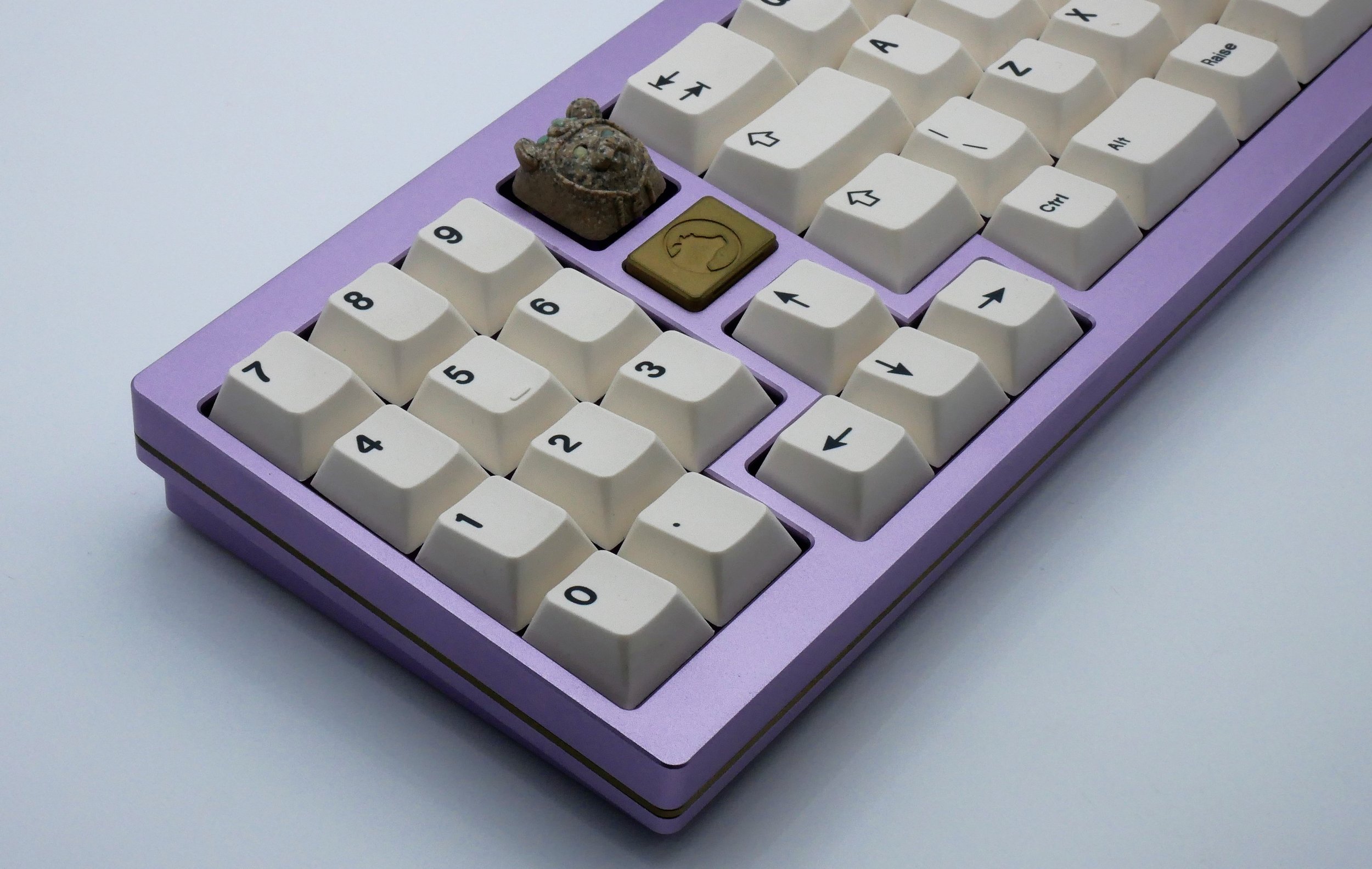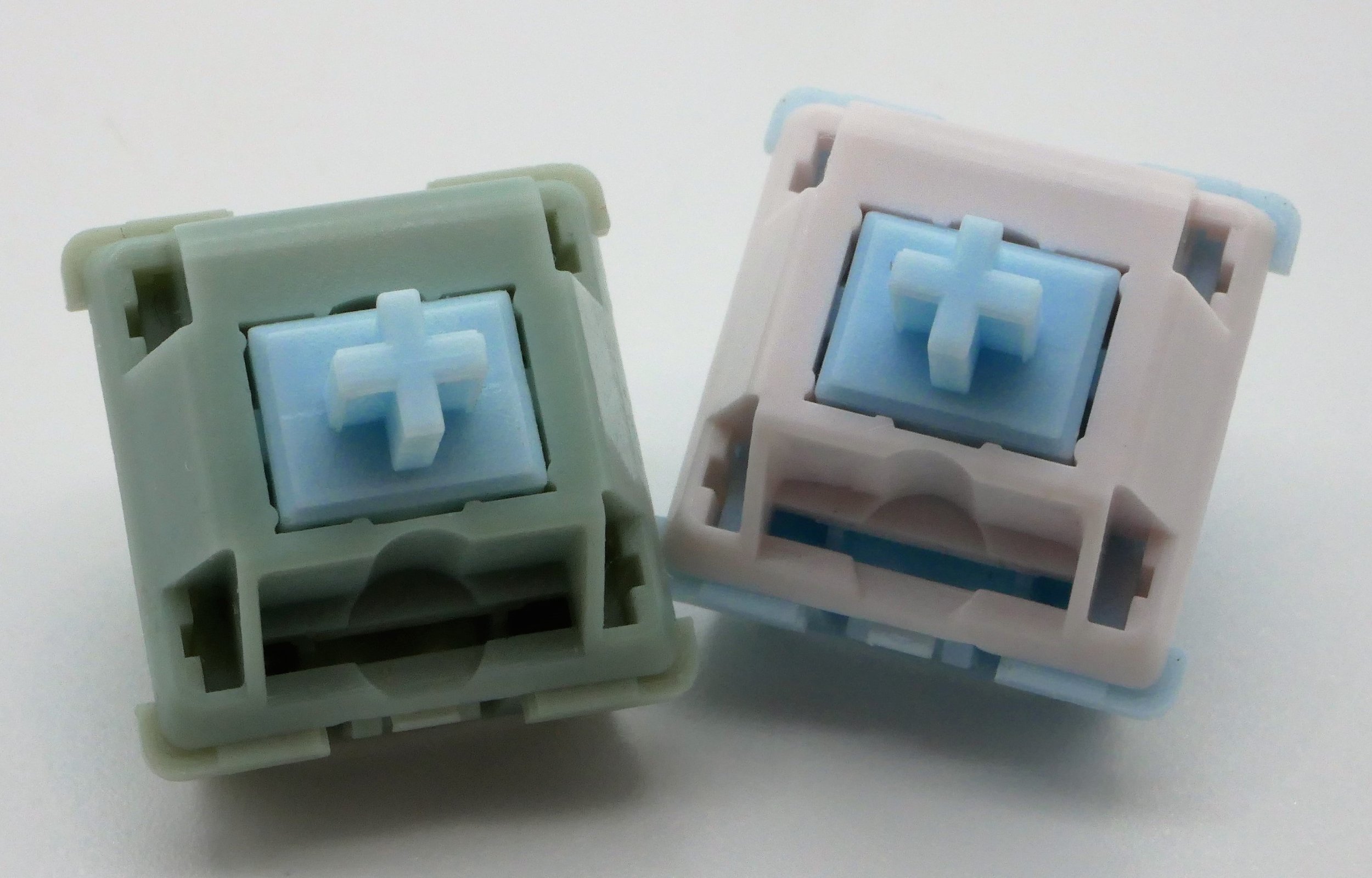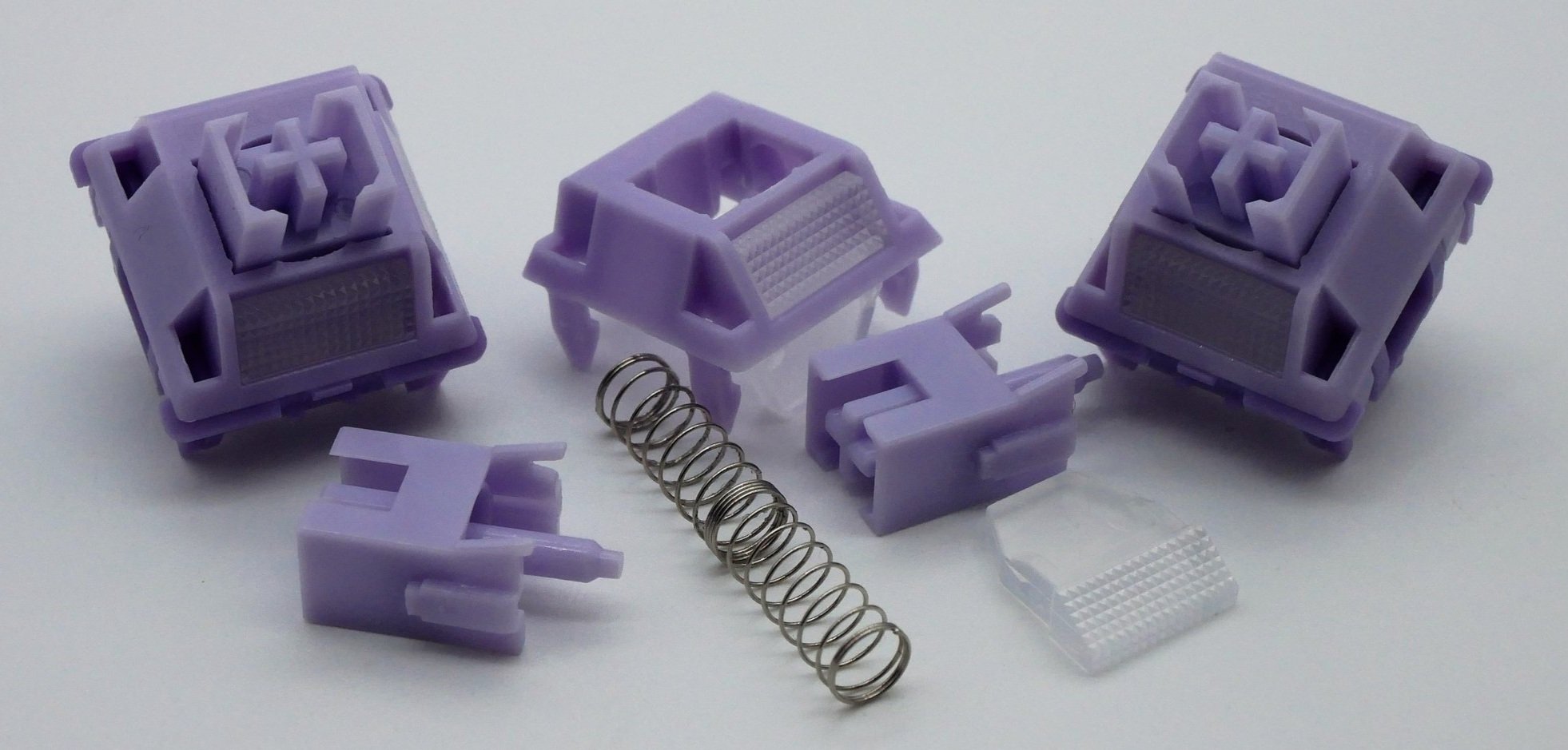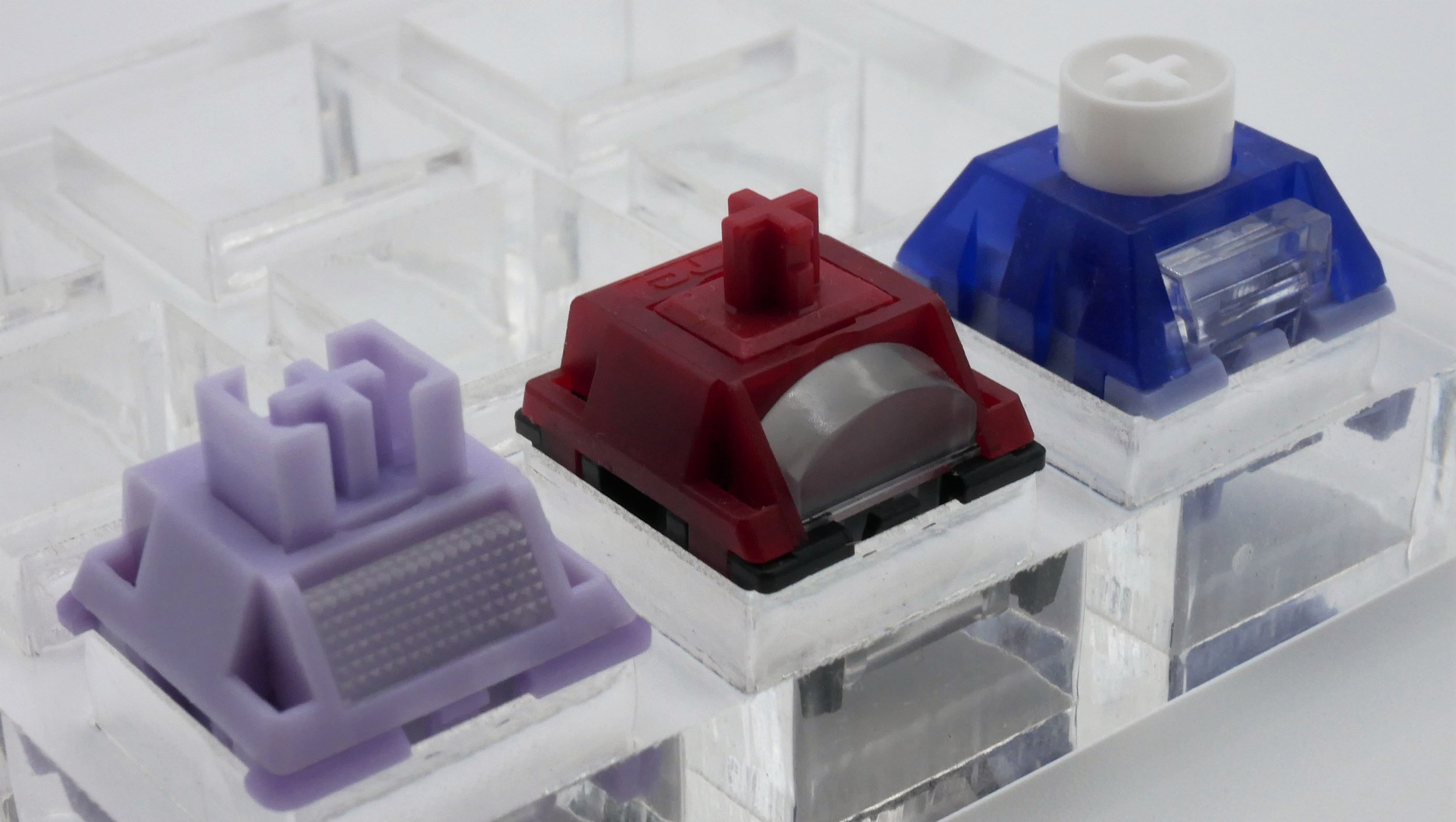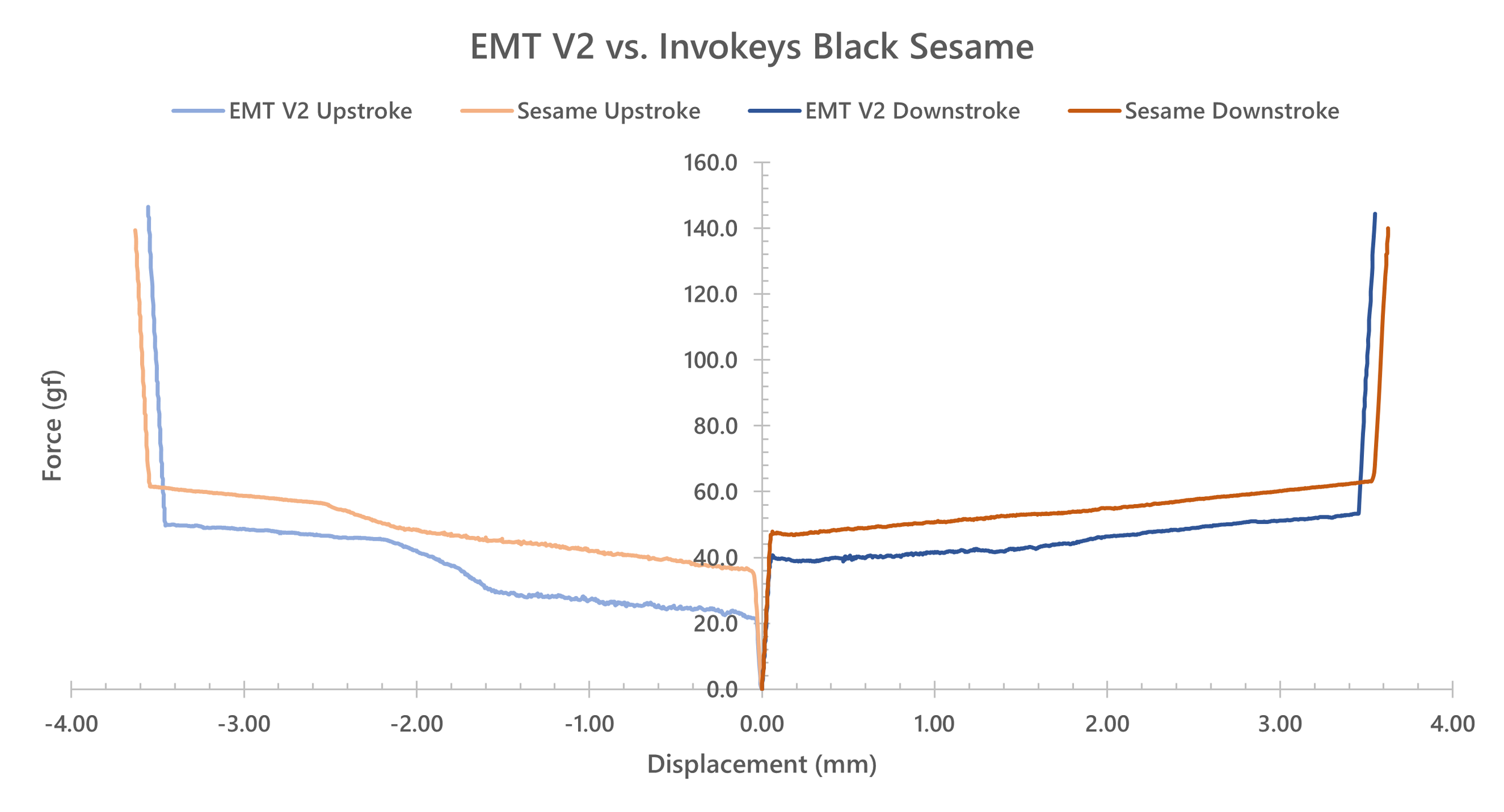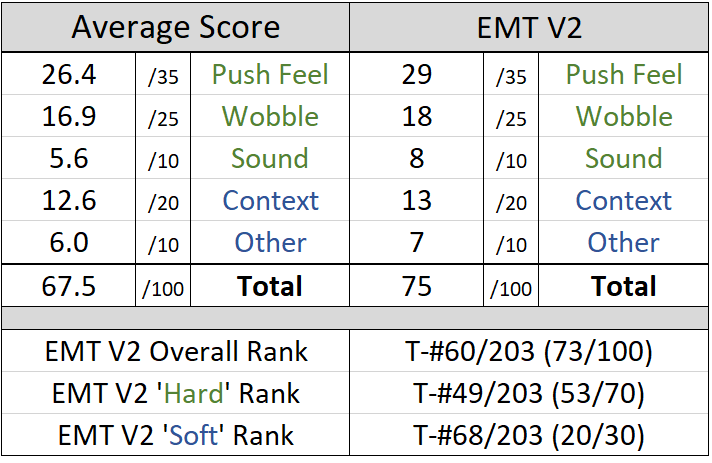EMT V2 Switch Review
One of the most common questions I get asked from people in the hobby is something to the effect of “Well what is your favorite switch, Goat?” Typically when I shrug off that answer because I’ve tried too many switches to actually have a favorite, I then usually get presented with alternative forms of the question such as: “What switches do you use in your keyboards?”, “What switches wouldn’t you use in your keyboards”, or “If you could build your dream keyboard what switches would you use?” Rather than being bashful and refusing to answer these questions eternally, I figure I might as well share what I use in my work keyboard as it is more or less what inspired me to do this review in the first place. Pictured below is my keyboard that I use in my office at school:
Figure 1: 'Mystery' Lilac Clarabelle with PBT Ivory caps and EMT V1 switches.
I should note here at the beginning of this paragraph that all of those people who rushed out to buy what is left of the EMT V1s out there after reading my tacit endorsement of them in the previous paragraph are going to be mildly disappointed. See, while they are pretty good switches overall, they certainly aren’t great. One thing in particular that I sought them out for is that there is some degree of scratch to them that is especially present in the batch that I received. Wanting something to keep me entertained on the long lab days and because I simply have too many switches to pick a perfect one for a board, I built this Clarabelle with these EMTs completely unlubed with the full intent of seeing how much I could smooth them out in time with nothing but use. I can’t say I regret my decision at all, but yeah, I can understand how that is slightly unhinged. Though, given that I type on EMT V1s almost every day, I kind of felt compelled to look into the EMT V2s a bit to see what is up with them. No really, that was all the thought process that went into picking this one.
Figure 2: And there they are - stock EMT V1s in all of their scritchy scratchy glory.
Switch Background
Figure 3: EMT V2 switches.
Okay, so clearly I must have screwed up this one, right? I mean just look at Figures 2 and 3 side by side and you’ll see they are definitely not related to each other. They don’t look the same, they’re not colored the same, and they definitely don’t seem like they came from the same manufacturer. While I can only do so much in this fourth wall break to assuage your fears about me going insane or colorblind, I want to state that this is not in fact an error on my part. In both the current interest check for the EMT V2s as well as the original sales page of the EMT V1s, it is stated that the switches were inspired by the half-elf candidate King of the Dragon Kingdom of Lugnica in the anime Re:Zero named Emilia. (You have no idea how many times I hard to rewrite that sentence because this shit looks like word salad to me.) Additionally, your very valid points that you brought up after I force fed them to you about these not seemingly being made by the same manufacturers are also correct. Whereas the EMT V1s are some of the only modern custom BSUN-made switches, the new EMT V2s appear to have molds that indicate that they are being manufactured by the new and upcoming manufacturer by the name of Haimu. But, what if I told you that this is not the first time there has been a strange disconnect between subsequent versions of switches released throughout time?
For those of you who are slightly more researched on switches and their history, the first example you likely jumped to is that of the ‘Tangerine’ line of switches which has become quite popular in recent years. While many newer comers to the hobby likely recognize C3 Equalz Tangerine V2 switches for their iconic translucent orange housings made by JWK, it should be noted that the original, V1 iterations of the Tangerines were actually made by Gateron instead. Coming in milky top housings over black bottom housings with an orange stem, the original Gateron Tangerine switches were offered in 67g weightings only and were exclusively available in China. Branching out to an entirely milky-housed option with a 62g spring, the Gateron Tangerines then made their ‘V1.5’ release to the world and no longer remained an eastern-exclusive.
Figure 4: Tangerine Family of switches including C3 Equalz Tangerine V2s (Left) and Gateron Tangerines (Right).
Following the rise of Durock/JWK, C3Equalz and TKC chose to resurrect the line of Tangerine switches in a completely new color scheme manufactured by Durock/JWK. While I am uncertain if C3Equalz ran the original Tangerine groupbuys back in the day, their adoption of the moniker and design for their switches has certainly led to an explosion in their overall popularity. However, this is far from the only time in which Durock/JWK has continued in the the design and release of a switch originally designed and released by Gateron – and it puts the short history of the Tangerines to shame.
Figure 5: The start of the Giant Family of switches including Gateron milky and full baby blue V1s (Back Row) and JWK Transparent Giant V2 (Front).
Enter the ‘Giant’ family of switches. While certainly not actually referring to their actual size as they are the same scale as other normal MX releases, the original Gateron Giant switches were released in solid baby blue and milky housing with baby blue stem offerings likely around 2018 shortly following the Tangerine switches. While released wider than the initial Tangerine offerings, these baby blue KS3 switches more or less fell by the wayside in popularity until JWK picked up the reigns with the release of the ‘Transparent JWK Giant’. Dubbed ‘Giant V2’ in short by collectors, this entirely clear housing with slightly older baby blue colored stems was to the original Giant switches what the Equalz Tangerines were to their early Gateron counterparts. Unlike that of the C3Equalz Tangerine V2s, though, the Giant V2s most certainly did not take off with any sort of popularity or recognition by the community at large. So, Durock/JWK did what all good manufacturers do when tasked with a lack of success – they made changes and released another version…
Figure 6: Yet another Durock/JWK attempt at the Giant Family of switches including Giant V3 (Left) and Giant V4 'Frosties' (Right).
… and another one as well. Following in the years after the Giant V2s release and lukewarm acceptance, Durock/JWK manufactured both a Giant V3 and V4 switches, each with wildly different performances. The V3s, which came in entirely opaque grey housings alongside that of the Crane switches, quite frankly, sucked ass. Scratchy, pingy, and uniquely bad for a mid-history Durock/JWK release, we’ll brush right past these onto the much more recent and successful ‘Giant V4’s released in 2020. Coming in a white over baby blue housing design, Giant V4s, which were dubbed ‘Frosties’ for short, came with a double staged, gold plated 58g spring and were decently well received by the community at large. As of the time of writing this review, there are in fact still some of these switches in stock in various vendors around the world.
Figure 7: Tecsee-made, PangHu designed Giant V5 switch.
Not wanting to be stood up by Durock/JWK, though, Tecsee chose to follow in parallel in JWK’s meteoric rise by acquiring their own entry into the Giant family of switches. Turning the ‘Giant’ family into a name fitting for the number of releases under the name, Tecsee and designer PangHu released the Giant V5 and V6 in 2021 and 2022, with the latter only seeing a brief release in eastern-exclusive platforms with no wider releases as of the time of writing. Currently stocked all over the world, the Giant V5 switches take design cues from previous iterations of Giant switches and come in a milky top over baby blue bottom design as can be seen above in Figure 7. PangHu’s Giant V6 switches, though, appear to come in a trend-breaking colorway with white stems and baby blue housings – the first Giant family switch to not feature a baby blue stem.
Figure 8: Giant V6 Taobao sales page showing assumed designer name ‘PangHu’ translated as ‘Fat Tiger’.
With all of that in mind, while it is certainly strange that the second version of the EMT switches chose to migrate from BSUN to Haimu, it’s certainly not the strangest journeyman history of switches out there to date. While there are no prices listed for the EMT V2 switches as per the time of writing this review, the interest check on Geekhack from Moyu Studio shows them being stocked at various vendors all across the world alongside their tactile partner in ‘Betty’ switches, ostensibly also named after something weeb-y. Coming with double staged springs rated for 58g of bottom out force, the EMT V2 switches are also marketed as coming in nylon over nylon housing designs with a lengthened, factory lubed stem, and an entirely new LED diffuser design different rom that seen in switches previously. The plans for stocking or continued production of these switches after their groupbuy phase is unknown, though previous Moyu Studio releases (e.g. Hades, Poseidon, etc.) have remained in stock well past their initial release dates.
EMT V2 Switch Performance
Appearance
At the highest level, the EMT V2 switches come in a two-tone purple color scheme with the dustproof stem and nylon top housing being a lighter shade of purple than the darker purple nylon bottom housing. While I don’t have any weeb keycap sets to compare them to, the immediate comparison that comes to mind for the colors of these switches is that of the purple colors used in the GMK Frost Witch set. In addition to coming with a dustproof stem, these switches are also PCB mountable and come with a uniquely designed LED-diffuser which will be discussed further below.
Figure 9: EMT V2 switches and their components.
Looking first to the top housings of the EMT V2 switches, there are a few interesting features to pick out. First is that of the nameplate which appears, to me, to read ‘G SQUCRE’. While G-Square is a brand which has released other switches such as that of the Moondrop x G-Square Tessence and Lunalight on Drop, it’s uncertain if this nameplate is referring to them as it doesn’t actually say ‘G SQUARE’. As of the time of publishing, I quite frankly have no idea what this is supposed to be or how these ended up spelled in this fashion. The other distinguishing feature in these four pin top housings is that of the large rectangular slot where the LED diffuser is fitted. While the concept of an LED diffuser is far from novel and has been popularized by manufacturers like TTC, this LED diffuser design in which the sloped edge at the top edge of the switch is textured is not something I’ve seen prior. What efficacy this design actually has on diffusing light versus a more conventional polished diffuser edge is dubious, at best, but it certainly makes a convincing design statement. Unlike that of other switch diffusers, as well, the EMT V2 diffusers appear much more easily removed from the switch top housing.
Figure 10: EMT V2 nameplate showing 'G SQUCRE' branding.
Figure 11: EMT V2 top housing external design with emphasis on LED diffuser location and orientation
Figure 12: LED diffuser shape and design comparison between Haimu (Purple), TTC (Red), and Kailh (Blue).
Internally, the top housings are much less interesting than their exterior design, and feature not really many peculiar details of note. While the edges where the slider rails rest in the completely at rest position do appear to be slightly more sloped than that of other switch top housings to my eye, this may very well be something that I am entirely imagining. Like other switch top housings, the EMT V2s also feature mold ejector marks in the form of four small circles in each corner of the top housing as well as a flat, rectangular pad on the edge underneath the LED region. The mold markings for the top housings are located, very uniquely, on the exterior LED edge and are centered in an extremely small, shallow indentation. Even though it is hardly able to be made out to the eye, I’ve been able to see single capital letters as the mold markings in some of the switches which I inspected. Whether or not this is a general practice for Haimu, who is the manufacturer of the EMT V2 switches, is beyond me until I get the chance to review more of their switches in the future.
Figure 13: EMT V2 top housing internal design showing mold ejector marking on upper rim as well as small mold marking spot on the front lip.
Figure 14: Close up of the EMT V2 mold marking box showing single, capital letter mold marking.
Moving next to the stems of the EMT V2s, they too are surprisingly free from many noteworthy details. Dustproof in construction, they interestingly don’t appear to have any transverse or sagittal seams which have been previously seen in other dustproof stems which I’ve review on this site such as Gateron Kangaroo Inks. Also unlike Gateron Kangaroo Inks, the EMT V2 stems have no obvious mold ejector or injection circles on either their front plate or back plate, which is a bit unorthodox. As well, their slider rails have no taper, which is also becoming less common in switches as more and more custom designs are beginning to be pumped out. The only real point of interest in inspecting the stems, perhaps, is in seeing a small and uneven distribution of factory lube on just the slider rail sides of the dustproof stems. While most certainly there and having an effect as noted in the ‘Push Feel’ section below, it is evident just by sight alone that they are lacking in consistency both within switch and between switches in a batch.
Figure 15: EMT V2 dustproof stem showing non-tapered slider rails and featureless front panel.
Finally arriving to the bottom housings of the EMT V2 switches, we encounter several mold-level details which strongly support the stance that these were made by Haimu. Internally, the bottom housings are more or less similar to other common designs, featuring eight ejector mold marks along the upper rim as well as a large south side spring collar. Most indicative of Haimu manufacturing, though, is a pair of holes on either side of the central hole in the bottom housing, which has been noted in the Haimu Whispers and Hearbeat switches to help silence their overall sound. On the underside of the bottom housing as well, the PCB mounting pins have noticeable rings around their bases which has also been a common design feature in Haimu-made switches released his year. As for mold markings, there appears to be a very small logo containing a G, and thus likely indicative of the mysterious ‘G SQUCRE’ brand, between the metal PCB pins. Beneath the left PCB mounting pin on all of the switches in my batch there is a ‘2’, whereas under the right PCB mounting pin there is a pair of two-digit codes which ostensibly are mold marking classifications. It is worth noting, as well, that the double-digit mold marking also uses the same font as has been previously reported on Haimu switches.
Figure 16: EMT V2 bottom housing internal design showing mold ejector circles on upper rim, south side spring collar, and through-housing holes indicative of Haimu.
Figure 17: EMT V2 bottom housing external design showing 'GS' and numerical mold markings as well as rings around the PCB mounting pings indicative of Haimu.
Push Feel
At the broadest level, the EMT V2 switches very much accomplish the majority of the checklist points for modern linear switches in the custom mechanical keyboard scene. In addition to being smooth but not overly smooth, they have a pair of well-balanced housing collisions that feel solid and singular with no weirdly pointed bits or spring crunching. Looking more closely at the finer details though, there are some subtle points which stand out with respect to their smoothness as well as their housing collisions. Regarding the smoothness, as is noted above in the ‘Appearance’ section, the visually inconsistent application of factory lube does cause some switches to feel inconsistent, with some feeling ever so slightly thicker and as if the stems have more drag than other, lesser lubed ones. On average, the switches are fairly lightly lubed and still maintain some small grain characteristic scratch that is subtle but present to the touch. As for the housing collisions, while they are well balanced with medium firmness at both ends, it does feel a bit on the thin side for what is implied by the housings being made of nylon.
Comparing the actual force curve of the EMT V2 switch to how it performs in hand, there isn’t really anything that stands out as compelling to note. As was indicated about the length of the stem leading to a shortened travel distance, the EMT V2 switches appear to start bottoming out in the realm of approximately 3.500 mm, half a mm shorter than conventional switch travel distances. The only other thing perhaps somewhat worthy of note here is that the force curve is relatively ‘flat’ in that the start of the downstroke force isn’t significantly lesser than that of the bottoming out force at the end of the downstroke.
Figure 18: EMT V2 force curve diagram.
Sound
The sound of the EMT V2 switches is certainly one of the more interesting points about these switches outside of their initial eye-catching design. In much the same way as I state above regarding the housing collisions, these switches should definitely not be thought of as having a nylon-based sound, which is often regarded by many in the community to be much deeper and muted than what is actually present here. Instead, the housing collisions are of medium firmness with just a slight bit of sharpness that sits them pretty squarely in the goldilocks middle between thin polycarbonate housing collisions and thick nylon-based ones. While it is as prone as any switch to increase in pitch with higher actuation speeds, the holes in the base of the EMT V2s do appear to help in balancing out the housing collisions in terms of their pitch differences as typing speeds increase. As for features outside of the housing collisions, any sound that comes about as a function of the aforementioned small grain scratch is negligible when compared to the medium volume housing collisions. There are otherwise no other sounds from leaf nor spring ping that are present in the EMT V2s.
Wobble
By comparison to other brands, I have a noticeably smaller body of experience with respect to Haimu than manufacturers such as Durock/JWK, Gateron, etc. That being said, the amount of stem wobble seen in the EMT V2s appears to very much fall in line with what little experience I do have from Haimu. While by no means severely wobbly, there is a bit more wobble in the EMT V2s than in other current, premium brands, and especially in the N/S direction. Even with it being fairly consistent across the batch of switches which I received, it teeters on the edge of being bothersome to more than just those super sensitive to wobble and/or using taller keycap profiles.
Measurements
If you’re into this level of detail about your switches, you should know that I have a switch measurement sheet that logs all of this data, as well as many other cool features which can be found under the ‘Archive’ tab at the top of this page or by clicking on the card above. Known as the ‘Measurement Sheet’, this sheet typically gets updated weekly and aims to take physical measurements of various switch components to compare mold designs on a brand-by-brand basis as well as provide a rough frankenswitching estimation sheet for combining various stems and top housings.
The latest in the content-adjacent work that I’ve picked up, the new ‘Force Curve Repository’ is now hosted on GitHub alongside the Scorecard Repository and contains all force curves that I make both within and outside of reviews. In addition to having these graphs above, I have various other versions of the graphs, raw data, and my processed data all available for each switch to use as you please. Check it out via the ‘Archive’ tab at the top of this page or by clicking any of the force curve cards above.
Break In
Break In Notes
17,000 Actuations
- At 17,000 actuations, the EMT V2 switches pick up a slightly higher pitched tone to their topping out as well as begin to drift a bit from the topping out/bottoming out sound balance that they otherwise have in their stock form.
- As is the norm for the vast majority of switches tested on this site using the break in machine, the stem wobble slightly increased in all directions at 17,000 actuations as compared to the stock form.
34,000 Actuations
- The same features as previously noted in the 17,000 actuation tested samples are no more or less present at 34,000 actuations than they were then. This applies to both the upward shift in the pitch as well as the stem wobble.
- In addition to the upward shift in pitch in the switches, which I would likely guess is a function of lube migration during the break in period, the switches at 34,000 actuations begin to become a bit scratchier to the touch as well.
51,000 Actuations
- As compared to the stock EMT V2 switches, the 51,000 actuation switches are noticeably more scratchy and carry with them a noticeable small grain scratch rather than a subtle character underneath an otherwise smooth switch.
- With respect to the stem wobble, at 51,000 actuations the EMT V2s have noticeably more N/S and E/W direction stem wobble than their stock counterparts.
Comparison Notes to Other Notable Linear Switches
Note – These are not aimed at being comprehensive comparisons between all factors of these switches as this would simply be too long for this writeup. These are little notes of interest I generated when comparing these switches to the EMT V2 switches side by side.
Figure 23: Switches for comparison. (L-R, Top-Bot: EMT V1, Invokeys Black Sesame, Obsidian Pro, Designer Studio Taoyao, Gateron KS9 Pro 2.0 Yellow, Kinetic Labs Husky)
EMT V1
- While both switches do have some amount of scratch to them, the EMT V1 switches have a much more noticeable and larger grain scratch throughout their stroke.
- Surprisingly, even though the EMT V1 switches were made as one of BSUN’s extremely few modern custom switches, they have stem less wobble than the currently much more active Haimu-made EMT V2 switches.
- In terms of overall sound, the EMT V2 switches are noticeably louder and collide with the housings in a more forceful and pointed manner than that of the comparatively soft, bouncy housing collision sounds in the EMT V1 switches.
Invokeys Black Sesame
- With no real surprise to anyone who has tried many of Invokeys’ recent linear switches from Aflion, the factory lubing on the Invokeys Black Sesames is both noticeably more consistent than the EMT V2s and also produces an all-around smoother switch.
- There is less N/S and E/W direction stem wobble in the Invokeys Black Sesame switches than there is in the EMT V2 switches.
- In a very strange way, the EMT V2 switches almost sound like a lighter version of the Invokeys Black Sesame switches in that their housing collisions have a similar overall volume and general feeling to them, though simply different in pitch.
Obsidian Pro
- While the EMT V2 switches have a much more singular, sharper sound than the Obsidian Pro switches, these two are by far the most comparable to each other of any of the switches on this list with respect to their sound.
- There is less N/S and E/W direction stem wobble in the EMT V2 switches than is in the Obsidian Pro switches.
- Interestingly, the Obsidian Pro switches feel smoother than that of the EMT V2 switches. That being said, though, they definitely don’t feel as good as the EMT V2s? While that is wholly uncharacteristically subjective of me, the thinner and more cheap feeling of the Obsidian Pros as compared to that of the EMT V2s makes them feel less substantial, and almost toy-like in comparison.
Designer Studio Taoyao
- While the EMT V2 and DS Taoyao switches have comparable amounts of scratch in their sound, the EMT V2s are notably lacking in spring ping which is otherwise a large component of the Taoyao’s sound.
- Even though neither of these switches are overwhelmingly scratchy, it is present enough to affect the overall switch feeling. Whereas the EMT V2s have a subtle, small grain scratch, the Taoyaos almost have a sort of slippery, stick like feeling in their scratch that almost feels as if it is interrupting the stroke up or down.
- With regard to N/S and E/W stem wobble, the EMT V2s have quite a bit less than the Designer Studio Taoyao switches.
Gateron KS9 Pro 2.0 Yellow
- In terms of overall sound, the KS9 Pro 2.0 Yellows are significantly more quieter and less higher pitched at topping out than the EMT V2 switches.
- These switches are surprisingly close to each other in terms of smoothness with factory lubrication applied. The place where the KS9 Pro 2.0 Yellows stand out over that of the EMT V2s, though, is that the lube application is a bit more consistent across a batch of switches.
- The bottoming out feeling of the Pro 2.0 Yellows is rather muted and firm feeling whereas the bottoming out of the EMT V2s is noticeably pointed and comparable to switches bottom out onto stem poles.
Husky
- While both of these switches are shifted towards the higher pitched end of the spectrum in terms of topping out sound, in a similar fashion as been mentioned above, the EMT V2s have a much more singular, sharpened sound than the Husky switches.
- The stem wobble between these two switches is fairly comparable, with the EMT V2s perhaps edging out the Huskies by the slightest margin in both directions.
- In terms of straight out of the box smoothness, the EMT V2s are slightly smoother throughout their stroke and across the batch than that of the Husky switches.
Scores and Statistics
Note – These scores are not necessarily completely indicative of the nuanced review above. If you’ve skipped straight to this section, I can only recommend that you at least glance at the other sections above in order to get a stronger idea of my opinion about these switches.
Push Feel
The EMT V2 switches are a very strong entry from a relatively new manufacturer in Haimu. While slightly inconsistently factory lubed, the switches are smooth but still lightly lubed enough to retain some character. As well, even though the housings are marketed as nylon, the well-balanced topping and bottoming out come somewhere squarely in between thin polycarbonate-like and thick nylon-like housing collisions.
Wobble
Having more N/S than E/W stem wobble and no top housing wobble, these teeter just on the edge of potentially being bothersome to others than just that small subsection of users who are super sensitive to switch wobble and/or using tall keycap profiles in their builds.
Sound
While definitely slightly higher pitched and shaper than what the nylon housing marketing would lead you to believe, the EMT V2s have a very strongly balanced topping and bottoming out that sound nearly the same even as the pitch increases. Tack this onto the fact that the small grain character scratch which is noted above is not present in the sound, and you have a pretty good sounding switch.
Context
Having not even hit the point in the interest check in which prices have been announced, the roster of vendors looking to stock EMT V2s speaks well to the fact that these switches will likely have a wide berth and chance to succeed in the community. If priced reasonably, these have a good chance to have some staying power, and not just with the weebs.
Other
In addition to a relatively strong showing by a newer manufacturer in Haimu, the presence of both the entirely new LED diffuser design as well as continued use of the bottom housing holes are both things that could inspire or be the trend that picks up steam in future switch releases.
Statistics
If you are looking at this statistics section for the first time and wondering where the hell are the other 202 switches that I’ve ranked are, or what ‘hard’ versus ‘soft’ ranks refer to specifically, I’d encourage you to head on over to my GitHub linked in the table above or at the links in the top right hand of this website to check out my database of scorecards as well as the ‘Composite Score Sheet’ which has a full listing of the rankings for each and every switch I’ve ranked thus far.
Final Conclusions
Coming full circle to how I started this review, many people will also likely skip past this entire article above just to DM me on Twitter to ask if I would personally use these switches. In much the same way as I diplomatically try and step around this question when I can, I try and point to the good things about the switch in question. The EMT V2s are a fairly well produced linear switch by Haimu which not only have a little bit of room for aftermarket modifications but would likely be usable out of box for many people. The overall sound as well as the general smoothness without that sort of overlubed feeling that is common for many newer manufacturers to hit is certainly a few extra points in favor of the EMT V2s as well. Sure, the inconsistencies in the factory lubing as well as falling short with marketing expectations with respect to ‘nylon’ housings do detract a bit from the overall experience. That being said, though, it’s a pretty good performance whose community approval will likely largely be driven by the price that they command when they finally hit for sale. How the community will respond to these, in turn, is likely something that won’t be fully known for many more months. While I am inclined to say that I would likely use these switches in a build some day, I still have an entire work board full of EMT V1s that I smooth out before I move onto my next board. Maybe when I’ve run the V1s through a few million times I’ll get to the EMT V2s.
Sponsors/Affiliates
Mechbox UK
- A wonderful UK based operation which sells singles to switches that I’ve used above in my comparisons for collectors and the curious alike. Matt has gone out of his way to help me build out big parts of my collection, and buying something using this link supports him as well as my content!
KeebCats UK
- A switch peripheral company based out of the UK which sells everything switch adjacent you could ask for, they’ve been a huge help recently with my film and lube supply for personal builds, and they want to extend that help to you too. Use code ‘GOAT’ for 10% off your order when you check them out!
proto[Typist] Keyboards
- An all-things keyboard vendor based out of the UK, proto[Typist] is a regular stocker of everything from switches to the latest keyboard and keycap groupbuys. While I’ve bought things from the many times in the past, they also are a sponsor of my work and allow me to get some of the great switches I write about!
MKUltra Corporation
- We may have stolen a few government secrets to get this one together. MKUltra is a US vendor that truly fills all the gaps other vendors simply don’t offer and is continuing to expand their switch and switch related peripherals by the day. Use code ‘GOAT’ for 5% off your order when you check them out!
Divinikey
- Not only do they stock just about everything related to keyboards and switches, but they’re super friendly and ship out pretty quick too. Divinikey has been a huge help to me and my builds over the last year or two of doing reviews and they’ll definitely hook you up. Use code ‘GOAT’ for 5% off your order when you check them out!
ZealPC
- Do they really need any introduction? Zeal and crew kicked off the custom switch scene many years ago with their iconic Zealios switches and the story of switches today couldn’t be told without them. Use code ‘GOAT’ (or click the link above) for 5% off your order when you check them out!
MechMods UK
- A rising vendor based in the UK, Ryan and crew have been a pleasure to work with and have nearly everything you’d need to build your first or fourteenth keyboard. Go build your latest or greatest one right now with them by using code ‘GOAT’ at checkout for a 5% discount!
Dangkeebs
- A longtime supporter of the website and the collection, Dangkeebs has quite possibly the widest variety of switches of any vendor out there. Not only is their switch selection large, but it rotates and is constantly adding new stuff too. You’re going to need 5% off your order with my affiliate to save off the cost of all those switches!
SwitchOddities
- The brainchild of one my most adventurous proxies, SwitchOddities is a place where you can try out all the fancy, strange, and eastern-exclusive switches that I flex on my maildays with. Follow my affiliate code and use code ‘GOAT’ at checkout to save 5% on some of the most interesting switches you’ll ever try!
Cannonkeys
- Does anybody not know of Cannonkeys at this point? One of the largest vendors in North America with keyboards, switches, keycaps, and literally everything you could ever want for a keyboard always in stock and with an incredibly dedicated and loving crew. Follow my affiliate link above in their name to support both them and I when you buy yourself some switches!
Kinetic Labs
- One of the most well-rounded keyboard vendors out there, Christian and crew have been supporters of all my switch and switch-adjacent needs for some years now. I’m honored to have them as an affiliate and think you should check them out using my affiliate link above to support both them and I when you check out their awesome products!
